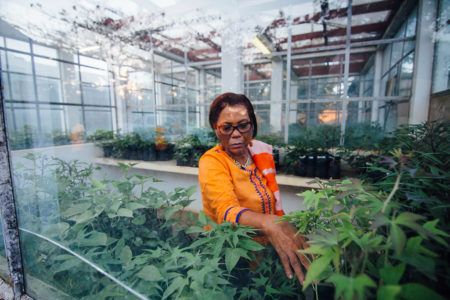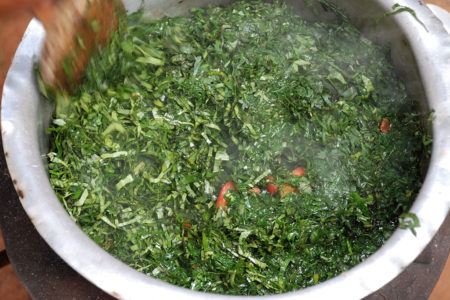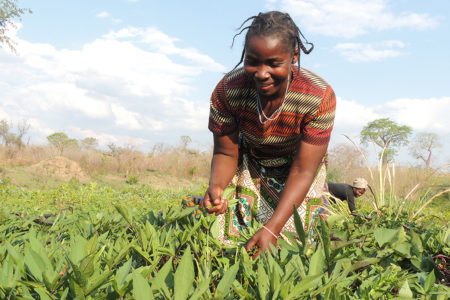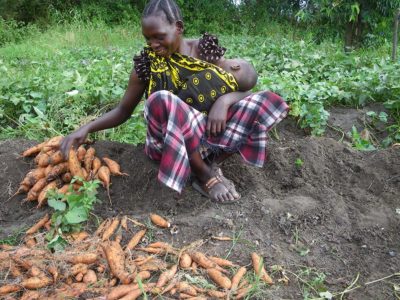
By the year 2026, the International Potato Center (CIP for its acronym in Spanish) aims to bolster the nutrition and food security of at least 50 million people in regions vulnerable to droughts, floods, salinity, and extreme weather in Africa, Asia, and Latin America. Sweetpotato is uniquely poised to help farmers cope with the effects of severe climatic conditions.
The project known as Climate Resilience through Sweetpotato (CReSP) is building on the success of breeding programs across Sub-Saharan Africa. Sweetpotato breeder, Dr. Maria Andrade, shares her thoughts on the unique role that sweetpotato plays in building food security in the face of climate change

How can sweetpotato help build food security in the face of climate change?
Sweetpotato is very easy to grow and you can eat the whole plant. It is high in nutritional content and produces during a drought where other plants, such as maize, fail. It can grow without pesticides. You only need a small amount of water and it begins to grow. When you plant sweetpotato, you already have the leaves to eat after two months. At three months you have the roots to eat. There are no other crops that can compare to sweetpotato in an emergency because it produces very quickly. Even people who are displaced can easily learn how to plant sweetpotato and produce food in two or three months.

How do climate-smart sweetpotatoes differ from other sweetpotatoes?
They are very different from other sweetpotatoes that are not drought-resistant. For example, the stem is much more vigorous; it is bigger in terms of diameter than the local drought sensitive varieties. The larger stem allows the sweetpotato to withstand drought because it takes in more water. It also has smaller leaves so that there is a smaller surface to lose water from in transpiration. As a breeder, I’m always looking for what a farmer can use. I want things to be dual purpose so that people consume both the leaves and roots. Mozambicans like to eat very narrow sweetpotato leaves, a trait which also happens to make the plants more drought-tolerant. We also breed for the high dry matter content that locals prefer, vigor, and how much the vines spread and cover the ground. Broader ground coverage means less water is lost to evaporation and more water is retained in the soil.
A lot of the local varieties that grew in Mozambique 20 years ago have disappeared because they could not withstand drought. Now we have 22 climate-smart varieties that are doing better, and they taste better as well.

Mozambique, where you are based, is where CIP first introduced sweetpotato as a way of re-establishing food systems after a disaster. Why is Mozambique an ideal testing ground for new climate-resilient varieties?
Mozambique is a country of catastrophes. In 1997 we had a cyclone. In 2003 we faced localized drought. In 2005 a full 75 percent of the country was under drought, and in the years 2009, 2013, and 2016, Mozambique suffered drought again. I looked at the rainfall distribution of the breeding sites I selected in southern Mozambique. Over the past 35 years, there was only a positive water balance in the year 2000. All those other years there was very minimal rainfall. To grow sweetpotato, I need at least 750 mm of rain spread across four to five months.
Umbelúzi is the perfect site because there is never enough rainfall to grow local sweetpotatoes. If I want to grow them, I must irrigate them. Whatever can grow in Umbelúzi, can grow anywhere in the country. In the province of Zambezia, I select for virus resistance because the virus pressure there is very high.

How do your breeding efforts in Mozambique adapt to the needs of other countries?
Southern Africa is known for its problem with droughts. If you want to release sweetpotato in this region it must have some tolerance to drought otherwise it will disappear from the system. From 2011-2016 the Mozambique program released 22 drought tolerant varieties that have since been adopted as far off as Abu Dhabi and Bangladesh, and have helped at least 500,000 Mozambicans feed their families in the face of recurrent drought.
I have been in emergencies in Angola and Mozambique in the aftermath of major drought. When the maize collapsed, sweetpotato continued growing. This year in Mozambique despite the droughts we still see national sales of roots and tubers in all the provinces because they are producing drought-tolerant sweetpotato. In the aftermath of floods and drought, people can produce some food to eat thanks to sweetpotato.

How do you ensure that the varieties and tools developed by CReSP meet the needs of both male and female farmers?
Farmer participation in the evaluation and palatability trials is crucial to the breeding process. We ask them to evaluate the varieties twice during the breeding process where we prepare the different sweetpotatoes and have them taste and select what they want. Usually in a household in a village, whatever the children like the mother will like, but for the taste of the male farmers in Africa, it has to have high dry matter content and have productivity. The children like the sweetpotato that is a little soft. Men like what is dry. We have all their tastes in mind.
Dr. Maria Andrade is a sweetpotato breeder based out of Mozambique. She is co-recipient of the 2016 World Food Prize for her innovative work to help combat micronutrient deficiency and food insecurity with biofortified orange-fleshed sweetpotato.
